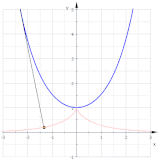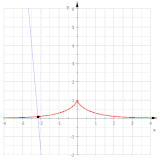Involute: Difference between revisions
→Involutes of a circle: do not use "similar" in geometry, except for the meaning defined in similitude (geometry) |
the lead part is shortened and simplified. Added citation to the lead single, simple definition. |
||
| Line 1: | Line 1: | ||
{{short description|A mathematical curve constructed from another curve}} |
|||
| ⚫ | |||
[[File:Evolvente-parabel.svg|thumb|Two involutes (red) of a parabola]] |
[[File:Evolvente-parabel.svg|thumb|Two involutes (red) of a parabola]] |
||
| ⚫ | |||
In [[mathematics]], an '''involute''' (also known as an '''evolvent''') is a particular type of [[curve]] that is dependent on another shape or curve. |
In [[mathematics]], an '''involute''' (also known as an '''evolvent''') is a particular type of [[curve]] that is dependent on another shape or curve. An involute of a curve is the [[Locus (mathematics)|locus]] of a point on a piece of taut string as the string is either unwrapped from or wrapped around the curve.<ref>{{Cite book|title=Geometry of Curves|last=Rutter|first=J.W.|publisher=CRC Press|year=2000|isbn=9781584881667|location=|pages=204}}</ref> |
||
It is a class of curves coming under the [[Roulette (curve)|roulette]] family of curves. |
|||
Involute curves are described using the [[differential geometry of curves]], and are obtained from another given curve by one of two methods. |
|||
* By attaching an imaginary taut string to the given curve and tracing its free end as it is wound onto that given curve; or in reverse, unwound. |
|||
* By a [[line segment]] that is [[tangent (geometry)|tangent]] to the curve on one end, while the other end traces out the involute. The length of the line segment is changed by an amount equal to the [[arc length]] traversed by the tangent point as it moves along the curve. |
|||
The [[evolute]] of an involute is the original curve |
The [[evolute]] of an involute is the original curve. |
||
The notions of the involute and evolute of a curve were introduced by [[Christiaan Huygens]] in his work titled ''[[Horologium Oscillatorium|Horologium oscillatorium sive de motu pendulorum ad horologia aptato demonstrationes geometricae]]'' (1673).<ref>{{cite book|first=John|last=McCleary|title=Geometry from a Differentiable Viewpoint|publisher=[[Cambridge University Press]]|date=1995|page=73}}{{ISBN missing}}</ref> |
The notions of the involute and evolute of a curve were introduced by [[Christiaan Huygens]] in his work titled ''[[Horologium Oscillatorium|Horologium oscillatorium sive de motu pendulorum ad horologia aptato demonstrationes geometricae]]'' (1673).<ref>{{cite book|first=John|last=McCleary|title=Geometry from a Differentiable Viewpoint|publisher=[[Cambridge University Press]]|date=1995|page=73}}{{ISBN missing}}</ref> |
||
== Involute of a parameterized curve == |
== Involute of a parameterized curve == |
||
Let be <math> \vec x= \vec c(t),\; t\in [t_1,t_2] </math> a [[regular curve]] in the plane with its [[Curvature (mathematics)|curvature]] nowhere 0 and <math>a\in (t_1,t_2)</math>, then the curve with the parametric representation |
Let be <math> \vec x= \vec c(t),\; t\in [t_1,t_2] </math> a [[regular curve]] in the plane with its [[Curvature (mathematics)|curvature]] nowhere 0 and <math>a\in (t_1,t_2)</math>, then the curve with the parametric representation |
||
* <math>\vec X=\vec C_a(t)=\vec c(t) -\frac{\vec c'(t)}{|\vec c'(t)|}\; \int_a^t|\vec c'(w)|\; dw </math> |
* <math>\vec X=\vec C_a(t)=\vec c(t) -\frac{\vec c'(t)}{|\vec c'(t)|}\; \int_a^t|\vec c'(w)|\; dw </math> |
||
is an ''involute'' of the given curve. |
is an ''involute'' of the given curve. |
||
The integral describes the actual length of the free part of the string in the interval <math>[a,t]</math> |
|||
and the vector prior to that is the tangent unitvector. Adding an arbitrary but fixed number <math>l_0</math> to the integral results in an involute corresponding to a string, which is extended by <math>l_0</math>. Hence: |
|||
The string acts as [[tangent (geometry)|tangent]] to the curve on one end, while the other end traces out the involute. The length of the string is changed by an amount equal to the [[arc length]] traversed by the tangent point as it moves along the curve. The integral in the equation describes the actual length of the free part of the string in the interval <math>[a,t]</math> and the vector prior to that is the tangent unit-vector. Adding an arbitrary but fixed number <math>l_0</math> to the integral results in an involute corresponding to a string, which is extended by <math>l_0</math>. Hence: |
|||
the involute can be varied by parameter <math>a</math> and/or adding a number to the integral (see [[#Involutes of a semicubic parabola|Involutes of a semicubic parabola]]). |
the involute can be varied by parameter <math>a</math> and/or adding a number to the integral (see [[#Involutes of a semicubic parabola|Involutes of a semicubic parabola]]). |
||
| Line 108: | Line 106: | ||
The [[High Flux Isotope Reactor]] uses involute-shaped fuel elements, since these allow a constant-width channel between them for coolant. |
The [[High Flux Isotope Reactor]] uses involute-shaped fuel elements, since these allow a constant-width channel between them for coolant. |
||
== Generalization == |
|||
The involute is an example of a [[roulette (curve)|roulette]] wherein the rolling curve is a straight line containing the generating point. |
|||
==See also== |
==See also== |
||
Revision as of 10:04, 1 October 2019
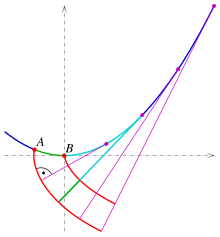
In mathematics, an involute (also known as an evolvent) is a particular type of curve that is dependent on another shape or curve. An involute of a curve is the locus of a point on a piece of taut string as the string is either unwrapped from or wrapped around the curve.[1]
It is a class of curves coming under the roulette family of curves.
The evolute of an involute is the original curve.
The notions of the involute and evolute of a curve were introduced by Christiaan Huygens in his work titled Horologium oscillatorium sive de motu pendulorum ad horologia aptato demonstrationes geometricae (1673).[2]
Involute of a parameterized curve
Let be a regular curve in the plane with its curvature nowhere 0 and , then the curve with the parametric representation
is an involute of the given curve.
The string acts as tangent to the curve on one end, while the other end traces out the involute. The length of the string is changed by an amount equal to the arc length traversed by the tangent point as it moves along the curve. The integral in the equation describes the actual length of the free part of the string in the interval and the vector prior to that is the tangent unit-vector. Adding an arbitrary but fixed number to the integral results in an involute corresponding to a string, which is extended by . Hence: the involute can be varied by parameter and/or adding a number to the integral (see Involutes of a semicubic parabola).
If one gets
Properties of involutes

In order to derive properties of a regular curve it is advantageous to suppose the arc length to be the parameter of the given curve. Because of the simplifications in this case: and , with the curvature and the unit normal, one gets for the involute:
- and
and the statement:
- At point the involute is not regular (because ),
and from follows:
- The normal of the involute at point is the tangent of the given curve at point and
- the involutes are parallel curves, because of and the fact, that is the unit normal at .
Examples
Involutes of a circle

For a circle with parametric representation , one gets . Hence , and the integral is . The equations of the involutes are:
The diagram shows involutes for (green), (red), (purple) and (light blue). The involutes look like Archimedean spirals, but they are actually not.
The arc length of the involute with is
Involutes of a semicubic parabola
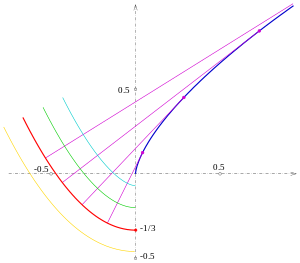
The parametric representation describes a semicubic parabola. From one gets and . Extending the string by causes an essential simplification of the calculation, and one gets
Eliminating parameter yields the equation of a parabola:
Hence:
- The involutes of the semicubic parabola are parallel curves of the parabola
(Parallel curves of a parabola are not parabolas anymore!)
Remark: The evolute of the parabola is the semicubic parabola (see section involute and evolute).
Involutes of a catenary
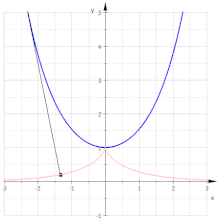
For the catenary , one gets , and because of , the length of the tangent vector is , and the integral Hence the parametric representation of the corresponding involute is
which describes a tractrix.
Result:
- The involutes of the catenary are parallel curves of the tractrix
Involutes of a cycloid
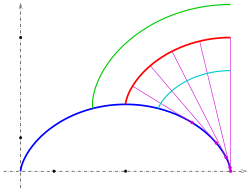
The parametric representation describes a cycloid. From , one gets and (trigonometric formulae were used).
Hence the equations of the corresponding involute are
which describe the shifted red cycloid of the diagram.
Result:
- The involutes of the cycloid are parallel curves of the cycloid
Involute and evolute
The evolute of a given curve consists of the curvature centers of . Between involutes and evolutes the following statement holds:[3][4]
- A curve is the evolute of any of its involutes.
Application
The involute has some properties that makes it extremely important to the gear industry: If two intermeshed gears have teeth with the profile-shape of involutes (rather than, for example, a traditional triangular shape), they form an involute gear system. Their relative rates of rotation are constant while the teeth are engaged. The gears also always make contact along a single steady line of force. With teeth of other shapes, the relative speeds and forces rise and fall as successive teeth engage, resulting in vibration, noise, and excessive wear. For this reason, nearly all modern gear teeth bear the involute shape.[5]
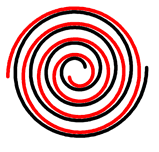
The involute of a circle is also an important shape in gas compressing, as a scroll compressor can be built based on this shape. Scroll compressors make less sound than conventional compressors and have proven to be quite efficient.
The High Flux Isotope Reactor uses involute-shaped fuel elements, since these allow a constant-width channel between them for coolant.
See also
References
- ^ Rutter, J.W. (2000). Geometry of Curves. CRC Press. p. 204. ISBN 9781584881667.
- ^ McCleary, John (1995). Geometry from a Differentiable Viewpoint. Cambridge University Press. p. 73.[ISBN missing]
- ^ K. Burg, H. Haf, F. Wille, A. Meister: Vektoranalysis: Höhere Mathematik für Ingenieure, Naturwissenschaftler und ..., Springer-Verlag, 2012,ISBN 3834883468, S. 30.
- ^ R. Courant:Vorlesungen über Differential- und Integralrechnung, 1. Band, Springer-Verlag, 1955, S. 267.
- ^ V. G. A. Goss (2013) "Application of analytical geometry to the shape of gear teeth", Resonance 18(9): 817 to 31 Springerlink (subscription required).

![{\displaystyle {\vec {x}}={\vec {c}}(t),\;t\in [t_{1},t_{2}]}](https://wikimedia.org/api/rest_v1/media/math/render/svg/c39b96578c926c9cfc44b8bab1621e67aac866f9)


![{\displaystyle [a,t]}](https://wikimedia.org/api/rest_v1/media/math/render/svg/1b7e4d6424116f83d1d8eadea305b1ccc9c8744e)



























































